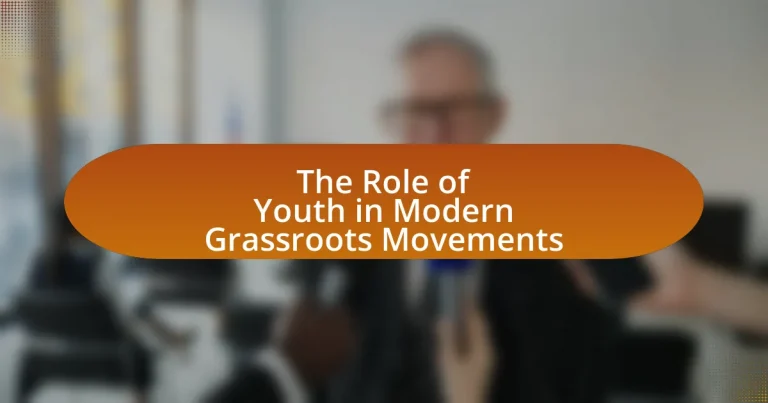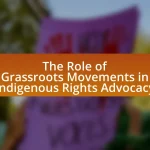The article examines the significant role of youth in modern grassroots movements, highlighting their contributions to activism, community mobilization, and the effective use of digital platforms for advocacy. It discusses how young people bring energy, innovative ideas, and a strong sense of social justice, influencing the goals and strategies of these movements. The article also addresses the challenges youth face, such as limited resources and generational divides, while emphasizing the impact of their engagement on public policy and societal change. Additionally, it explores future trends in youth activism, including increased digital engagement and a focus on intersectionality and sustainability.
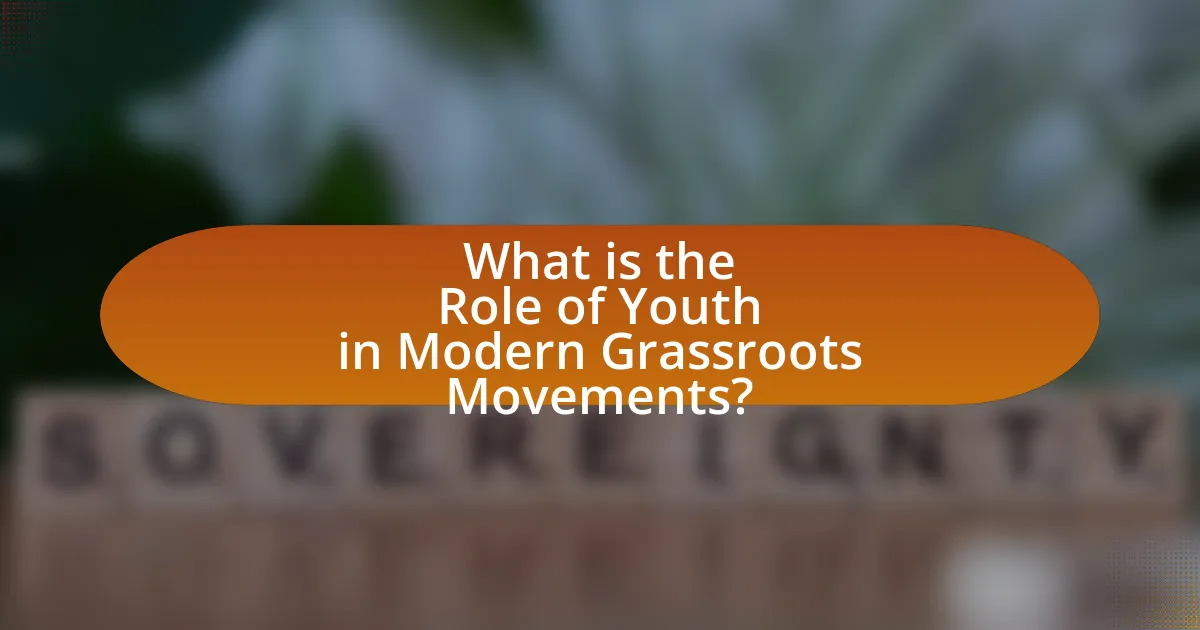
What is the Role of Youth in Modern Grassroots Movements?
Youth play a crucial role in modern grassroots movements by driving activism, mobilizing communities, and leveraging digital platforms for advocacy. Their engagement often leads to increased visibility for social issues, as seen in movements like Black Lives Matter and climate activism, where young people have organized protests and utilized social media to amplify their messages. According to a 2020 report by the Pew Research Center, 71% of young adults believe that social media is an effective tool for political engagement, highlighting their ability to influence public discourse and policy change.
How do youth contribute to grassroots movements?
Youth contribute to grassroots movements by bringing energy, innovative ideas, and a strong sense of social justice. Their involvement often includes organizing events, leveraging social media for outreach, and mobilizing peers to advocate for change. For instance, the youth-led March for Our Lives movement, initiated after the Parkland school shooting in 2018, effectively utilized social media platforms to raise awareness about gun control, demonstrating their capacity to influence public discourse and policy. Additionally, studies show that young activists are more likely to engage in direct action and community organizing, which are critical components of grassroots efforts aimed at addressing local and national issues.
What specific skills do young people bring to these movements?
Young people bring digital literacy, creativity, and strong communication skills to grassroots movements. Their proficiency in social media allows them to effectively mobilize support and spread awareness rapidly. For instance, during the 2019 climate strikes, youth activists utilized platforms like Twitter and Instagram to organize events globally, demonstrating their ability to engage large audiences. Additionally, their innovative approaches to problem-solving and advocacy contribute fresh perspectives, making movements more dynamic and relatable to a broader demographic.
How does youth participation influence the goals of grassroots movements?
Youth participation significantly influences the goals of grassroots movements by infusing fresh perspectives and innovative strategies that resonate with contemporary social issues. This demographic often drives the agenda towards inclusivity and sustainability, reflecting their values and priorities. For instance, the youth-led climate strikes initiated by Greta Thunberg mobilized millions globally, emphasizing environmental justice and demanding policy changes from leaders. Research by the Pew Research Center indicates that younger generations are more likely to engage in activism, with 70% of millennials and Gen Z expressing a desire to influence political decisions. This active involvement not only shapes the objectives of grassroots movements but also enhances their visibility and impact in society.
Why is youth involvement crucial in contemporary activism?
Youth involvement is crucial in contemporary activism because young people bring fresh perspectives, innovative ideas, and a strong sense of urgency to social issues. Their engagement often leads to increased visibility and momentum for movements, as evidenced by the global climate strikes initiated by youth activists like Greta Thunberg, which mobilized millions and raised awareness about climate change. Additionally, studies show that younger generations are more likely to utilize digital platforms for organizing and advocacy, making their participation essential in reaching broader audiences and influencing policy changes.
What historical context supports the importance of youth in activism?
Youth have historically played a crucial role in activism, significantly influencing social and political change. For instance, during the Civil Rights Movement in the 1960s, young activists like those involved in the Student Nonviolent Coordinating Committee (SNCC) organized sit-ins and freedom rides, demonstrating the power of youth-led initiatives in challenging systemic racism. Additionally, the anti-Vietnam War protests saw a surge of youth engagement, with college students mobilizing against military involvement, showcasing their ability to galvanize public opinion and effect policy change. These historical examples illustrate that youth activism has been pivotal in shaping societal norms and advancing civil rights, highlighting the enduring importance of young voices in activism.
How do societal changes impact youth engagement in grassroots movements?
Societal changes significantly enhance youth engagement in grassroots movements by fostering a sense of urgency and relevance among young people. For instance, the rise of social media has transformed communication, allowing youth to mobilize quickly around issues like climate change and racial justice, as seen in movements such as Fridays for Future and Black Lives Matter. Research indicates that 70% of young people feel more empowered to participate in activism due to increased access to information and community networks, highlighting the direct correlation between societal shifts and youth involvement.
What challenges do youth face in grassroots movements?
Youth face several challenges in grassroots movements, including limited access to resources, lack of experience, and generational divides. Limited access to resources often hinders youth from effectively mobilizing and organizing, as they may lack funding, venues, or materials necessary for their initiatives. Additionally, their lack of experience can lead to difficulties in navigating complex political landscapes and building coalitions, which are essential for successful grassroots efforts. Generational divides may also create barriers, as older activists might not fully understand or support the priorities and methods of younger participants, leading to conflicts and miscommunication. These challenges can impede the overall effectiveness and sustainability of youth-led grassroots movements.
How do socio-economic factors affect youth participation?
Socio-economic factors significantly influence youth participation by shaping their access to resources, opportunities, and social networks. For instance, youth from lower socio-economic backgrounds often face barriers such as limited access to education, financial constraints, and fewer opportunities for civic engagement, which can hinder their ability to participate in grassroots movements. Research indicates that youth in affluent areas are more likely to engage in community activities and advocacy due to better access to information and support systems. A study by the Pew Research Center found that socio-economic status correlates with levels of civic engagement, highlighting that youth from higher-income families are more likely to volunteer and participate in political activities. Thus, socio-economic factors play a crucial role in determining the extent and nature of youth involvement in grassroots movements.
What barriers exist within grassroots organizations that hinder youth involvement?
Barriers within grassroots organizations that hinder youth involvement include lack of accessibility, insufficient outreach, and generational disconnect. Many grassroots organizations do not provide adequate resources or platforms that are easily accessible to young people, limiting their participation. Additionally, outreach efforts often fail to effectively engage youth, resulting in low awareness of opportunities for involvement. Furthermore, a generational disconnect can lead to misunderstandings between older members and youth, creating an environment that may not feel welcoming or relevant to younger individuals. These factors collectively contribute to the underrepresentation of youth in grassroots movements.
How can youth effectively mobilize for change?
Youth can effectively mobilize for change by leveraging social media platforms to organize, raise awareness, and engage their communities. Research indicates that 90% of young people use social media, making it a powerful tool for communication and mobilization (Pew Research Center, 2021). By creating campaigns that resonate with their peers and utilizing hashtags to amplify their messages, youth can reach a broader audience and foster collective action. Additionally, collaborating with local organizations and participating in community events enhances their impact, as evidenced by the success of youth-led movements like March for Our Lives, which mobilized thousands for gun control reform.
What strategies have proven successful for youth-led initiatives?
Successful strategies for youth-led initiatives include grassroots organizing, leveraging social media for outreach, and fostering partnerships with established organizations. Grassroots organizing empowers youth to mobilize their communities effectively, as seen in movements like the March for Our Lives, which successfully advocated for gun control through local events and national campaigns. Social media serves as a powerful tool for engagement and awareness, allowing initiatives to reach a broader audience quickly; for instance, the #FridaysForFuture climate strikes gained global attention and participation through platforms like Twitter and Instagram. Additionally, forming partnerships with established organizations provides youth-led initiatives with resources, mentorship, and credibility, enhancing their impact, as demonstrated by collaborations between youth activists and NGOs during climate action campaigns.
How can technology enhance youth engagement in grassroots movements?
Technology enhances youth engagement in grassroots movements by providing platforms for communication, organization, and mobilization. Social media platforms like Twitter and Instagram allow young activists to share information rapidly, connect with like-minded individuals, and amplify their voices on critical issues. According to a study by the Pew Research Center, 72% of teens use social media, making it a vital tool for outreach and engagement. Additionally, mobile applications facilitate event organization and coordination, enabling youth to participate in protests and campaigns more effectively. The use of technology also allows for real-time updates and feedback, fostering a sense of community and urgency among young activists.
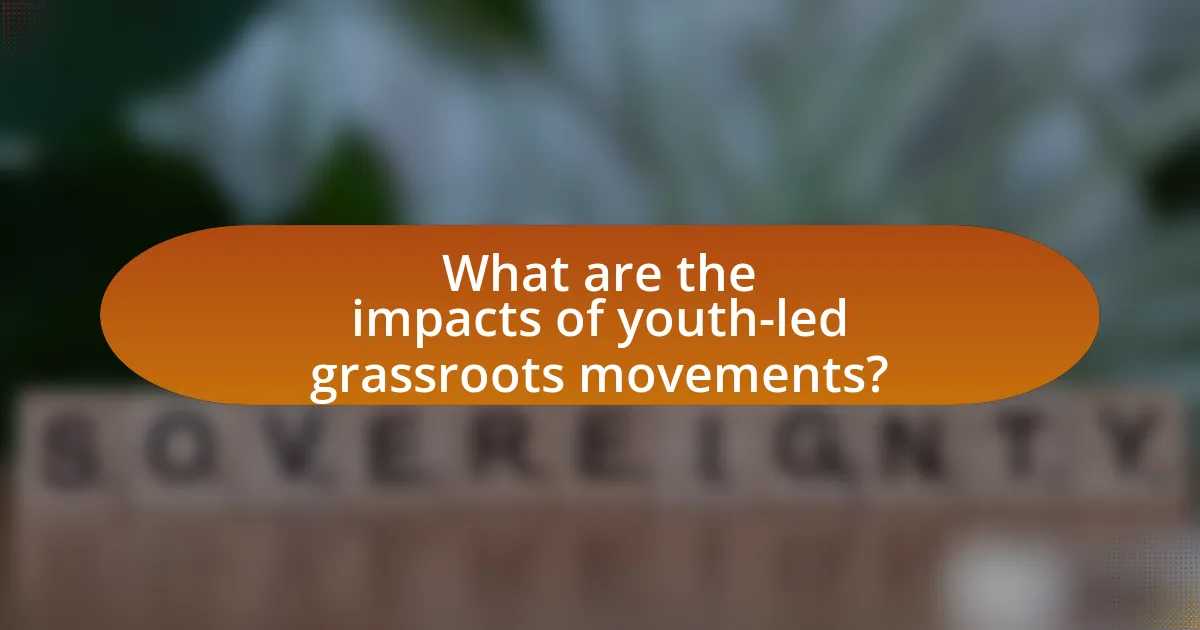
What are the impacts of youth-led grassroots movements?
Youth-led grassroots movements significantly impact social change by mobilizing communities, raising awareness, and influencing policy. These movements often harness social media to amplify their messages, as seen in the global climate strikes initiated by youth activists like Greta Thunberg, which mobilized millions and pressured governments to address climate issues. Research indicates that youth engagement in grassroots movements leads to increased civic participation, with studies showing that young activists are more likely to vote and engage in community service. Furthermore, these movements often challenge existing power structures, leading to shifts in public discourse and policy reforms, such as the advocacy for gun control following the Parkland shooting, which was largely driven by student activists.
How do these movements shape public policy?
Grassroots movements significantly shape public policy by mobilizing public opinion and influencing decision-makers. These movements often highlight social issues, such as climate change or racial justice, which can lead to legislative changes. For instance, the youth-led climate movement has pressured governments worldwide to adopt more stringent environmental regulations, evidenced by the increased commitments to carbon neutrality from various nations following widespread protests and advocacy. Additionally, grassroots organizations often engage in lobbying efforts, providing policymakers with research and data that support their causes, thereby facilitating the integration of community needs into formal policy frameworks.
What examples illustrate successful youth influence on legislation?
Successful youth influence on legislation is exemplified by the March for Our Lives movement, which advocated for gun control following the Parkland school shooting in 2018. This movement, led by students, resulted in significant legislative changes in several states, including Florida’s passage of the Marjory Stoneman Douglas High School Public Safety Act, which raised the minimum age for purchasing firearms and implemented waiting periods. Another example is the youth-led climate strikes, particularly the Fridays for Future movement initiated by Greta Thunberg, which has pressured governments worldwide to adopt more aggressive climate policies, leading to commitments like the European Union’s Green Deal aimed at achieving carbon neutrality by 2050. These instances demonstrate how organized youth activism can effectively shape public policy and influence legislative outcomes.
How do grassroots movements alter public perception on key issues?
Grassroots movements alter public perception on key issues by mobilizing community engagement and leveraging social media to amplify their messages. These movements often highlight specific concerns, such as climate change or social justice, which resonate with the public, particularly younger demographics. For instance, the youth-led climate movement, exemplified by initiatives like Fridays for Future, has significantly shifted public discourse around environmental policies, leading to increased awareness and urgency regarding climate action. Research indicates that grassroots campaigns can effectively change attitudes; a study published in the Journal of Social Issues found that grassroots activism can lead to a 20% increase in public support for policy changes related to social issues. This demonstrates that grassroots movements are powerful catalysts for altering perceptions and driving societal change.
What role does social media play in youth activism?
Social media serves as a crucial platform for youth activism by facilitating communication, mobilization, and awareness around social issues. It enables young activists to share information rapidly, organize events, and connect with like-minded individuals globally. For instance, the #BlackLivesMatter movement gained significant traction through social media, allowing youth to amplify their voices and mobilize protests effectively. Research by the Pew Research Center indicates that 72% of teens use social media, highlighting its potential as a tool for engagement and activism among young people.
How has social media changed the landscape of grassroots movements?
Social media has significantly transformed grassroots movements by enhancing communication, mobilization, and visibility. Platforms like Twitter, Facebook, and Instagram allow activists to quickly disseminate information, organize events, and rally support on a global scale. For instance, the Arab Spring in 2010-2011 showcased how social media facilitated real-time communication among protesters, leading to widespread mobilization against authoritarian regimes. Additionally, studies indicate that social media engagement can increase participation rates in movements; a 2018 Pew Research Center report found that 69% of Americans believe social media is an effective tool for raising awareness about social issues. This shift has empowered youth, who are often the primary users of these platforms, to lead and shape modern grassroots initiatives.
What are the risks and rewards of using social media for activism?
Using social media for activism presents both significant risks and rewards. The primary reward is the ability to reach a vast audience quickly, facilitating awareness and mobilization around social issues; for instance, the #BlackLivesMatter movement gained global traction through platforms like Twitter and Instagram, leading to widespread protests and policy discussions. Conversely, a notable risk is the potential for misinformation to spread rapidly, which can undermine the credibility of movements; a study by the Pew Research Center found that 64% of Americans believe misinformation is a major problem on social media. Additionally, activists may face online harassment or surveillance, which can deter participation and endanger personal safety.
What lessons can be learned from successful youth movements?
Successful youth movements demonstrate the importance of grassroots organization, effective communication, and the power of collective action. These movements often mobilize young people around shared values and goals, leveraging social media to amplify their message and reach a wider audience. For instance, the March for Our Lives movement, initiated by students after the Parkland shooting in 2018, effectively utilized social media platforms to organize protests and advocate for gun control, resulting in significant legislative discussions. Additionally, successful youth movements highlight the necessity of inclusivity and diversity, as seen in the global climate strikes led by youth activists like Greta Thunberg, which brought together individuals from various backgrounds to address climate change. These examples illustrate that successful youth movements can drive social change by fostering community engagement, utilizing technology for outreach, and promoting a unified vision for the future.
What common traits do successful youth-led movements share?
Successful youth-led movements share traits such as strong leadership, effective communication, and a clear vision. Strong leadership is often characterized by passionate individuals who inspire and mobilize others, as seen in movements like the March for Our Lives, which was driven by student leaders advocating for gun control. Effective communication, particularly through social media, allows these movements to reach a wider audience quickly, exemplified by the global impact of the Fridays for Future climate strikes initiated by Greta Thunberg. A clear vision helps unify participants around common goals, which is evident in the Black Lives Matter movement, where a focused agenda on racial justice has galvanized support across diverse demographics. These traits collectively enhance the movements’ ability to create significant social change.
How can these lessons be applied to future grassroots initiatives?
Lessons from past grassroots initiatives can be applied to future efforts by emphasizing the importance of youth engagement, strategic communication, and community collaboration. Engaging young people ensures fresh perspectives and innovative solutions, as evidenced by the success of movements like the March for Our Lives, which mobilized youth to advocate for gun control, demonstrating their capacity to influence policy. Strategic communication, utilizing social media platforms effectively, has proven essential for reaching broader audiences and mobilizing support, as seen in the Black Lives Matter movement. Additionally, fostering collaboration among diverse community groups enhances resource sharing and strengthens advocacy efforts, as illustrated by the success of local environmental initiatives that unite various stakeholders. These applications highlight the critical role of youth in shaping impactful grassroots movements.
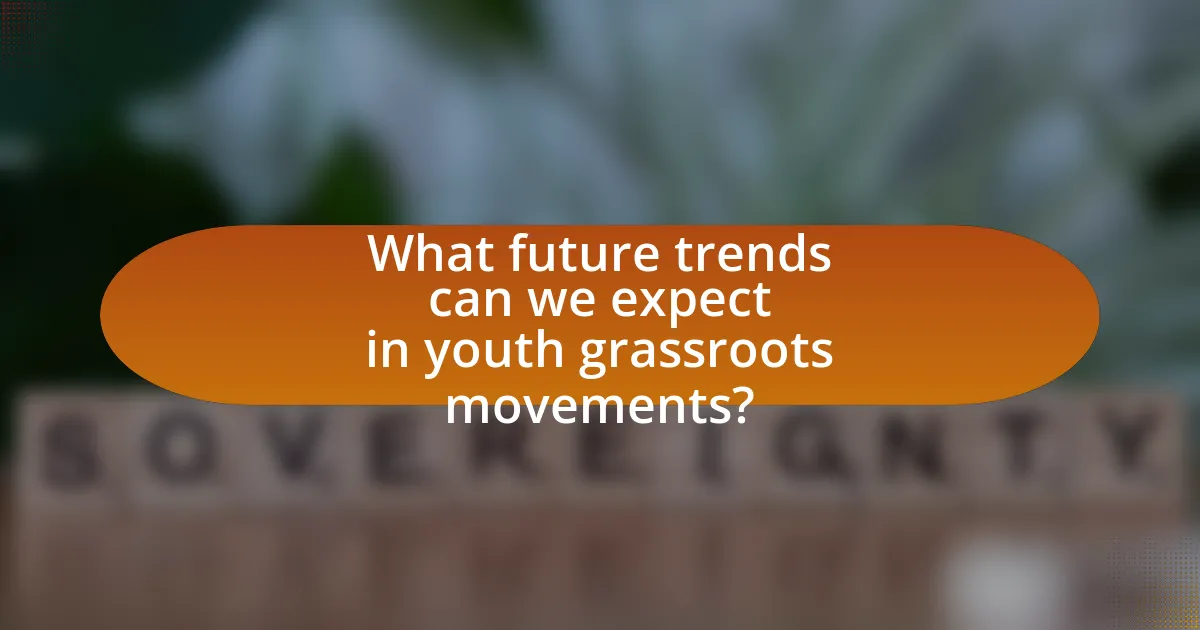
What future trends can we expect in youth grassroots movements?
Future trends in youth grassroots movements will likely include increased digital engagement, intersectionality in activism, and a focus on sustainability. Digital platforms enable youth to mobilize quickly and effectively, as seen in movements like Black Lives Matter and Fridays for Future, where social media played a crucial role in organizing and spreading awareness. Additionally, youth are increasingly recognizing the importance of intersectionality, advocating for diverse issues such as racial justice, gender equality, and climate action simultaneously. This holistic approach reflects a broader understanding of social justice, as evidenced by the rise of coalitions that unite various causes. Lastly, the emphasis on sustainability is becoming more pronounced, with young activists pushing for environmental policies and practices that address climate change, as highlighted by the global youth climate strikes. These trends indicate a dynamic and evolving landscape for youth grassroots movements.
How will changing demographics influence youth activism?
Changing demographics will significantly influence youth activism by diversifying the issues and perspectives that young activists prioritize. As populations become more multicultural and varied in socioeconomic status, youth activism will increasingly address a broader range of social justice issues, including racial equality, climate change, and economic disparity. For instance, the U.S. Census Bureau projects that by 2045, the majority of the U.S. population will be composed of minority groups, which will likely shift the focus of youth movements to reflect the needs and concerns of these communities. This demographic shift is already evident in movements like Black Lives Matter and climate activism, where young people from diverse backgrounds are leading the charge for systemic change.
What emerging issues are likely to mobilize youth in the coming years?
Emerging issues likely to mobilize youth in the coming years include climate change, social justice, mental health awareness, and digital privacy. Climate change remains a pressing concern, with youth-led movements like Fridays for Future highlighting the urgency for action, as evidenced by the increasing frequency of climate-related disasters. Social justice issues, including racial equality and gender rights, have gained momentum through movements such as Black Lives Matter, which resonate deeply with younger generations advocating for systemic change. Mental health awareness is also rising, particularly in the wake of the COVID-19 pandemic, prompting youth to demand better resources and support systems. Lastly, digital privacy concerns are becoming more prominent as young people navigate an increasingly surveilled online environment, leading to calls for stronger regulations and protections.
How can organizations adapt to engage the next generation of activists?
Organizations can adapt to engage the next generation of activists by leveraging digital platforms and social media to facilitate communication and mobilization. This generation is highly connected online, with 95% of teens using social media, making it essential for organizations to establish a strong digital presence. By creating interactive content, utilizing storytelling, and promoting grassroots campaigns through these channels, organizations can resonate with young activists’ values and priorities. Furthermore, incorporating educational resources and opportunities for skill development can empower youth to take action, as studies show that 70% of young people are motivated by a desire to make a difference. Engaging in partnerships with youth-led initiatives can also enhance credibility and foster a sense of ownership among young activists.
What best practices should youth follow in grassroots movements?
Youth should prioritize community engagement, effective communication, and collaboration in grassroots movements. Engaging with the community fosters trust and ensures that the movement addresses local needs. Effective communication, including the use of social media, helps to spread awareness and mobilize support quickly. Collaboration with diverse groups enhances the movement’s reach and impact, as seen in successful campaigns like the March for Our Lives, which united students across the U.S. to advocate for gun control. These practices are essential for building a strong, inclusive grassroots movement that can drive meaningful change.
How can youth leaders cultivate effective teamwork and collaboration?
Youth leaders can cultivate effective teamwork and collaboration by fostering open communication and establishing clear goals. Open communication encourages team members to share ideas and feedback, which enhances trust and understanding among participants. Establishing clear goals provides a shared direction, ensuring that all team members are aligned in their efforts. Research indicates that teams with defined objectives are 20% more productive than those without, highlighting the importance of goal-setting in collaborative environments. Additionally, youth leaders can implement team-building activities that promote relationship-building and problem-solving skills, further enhancing collaboration.
What resources are available to support youth in grassroots activism?
Youth in grassroots activism can access various resources, including training programs, funding opportunities, and online platforms. Organizations like the Youth Activism Project provide educational resources and workshops to equip young activists with skills in advocacy and organizing. Additionally, grants from foundations such as the Open Society Foundations support youth-led initiatives, enabling them to implement their projects. Online platforms like Change.org and social media networks facilitate outreach and mobilization, allowing youth to connect with broader movements and share their causes effectively. These resources collectively empower young individuals to engage actively in grassroots activism.
